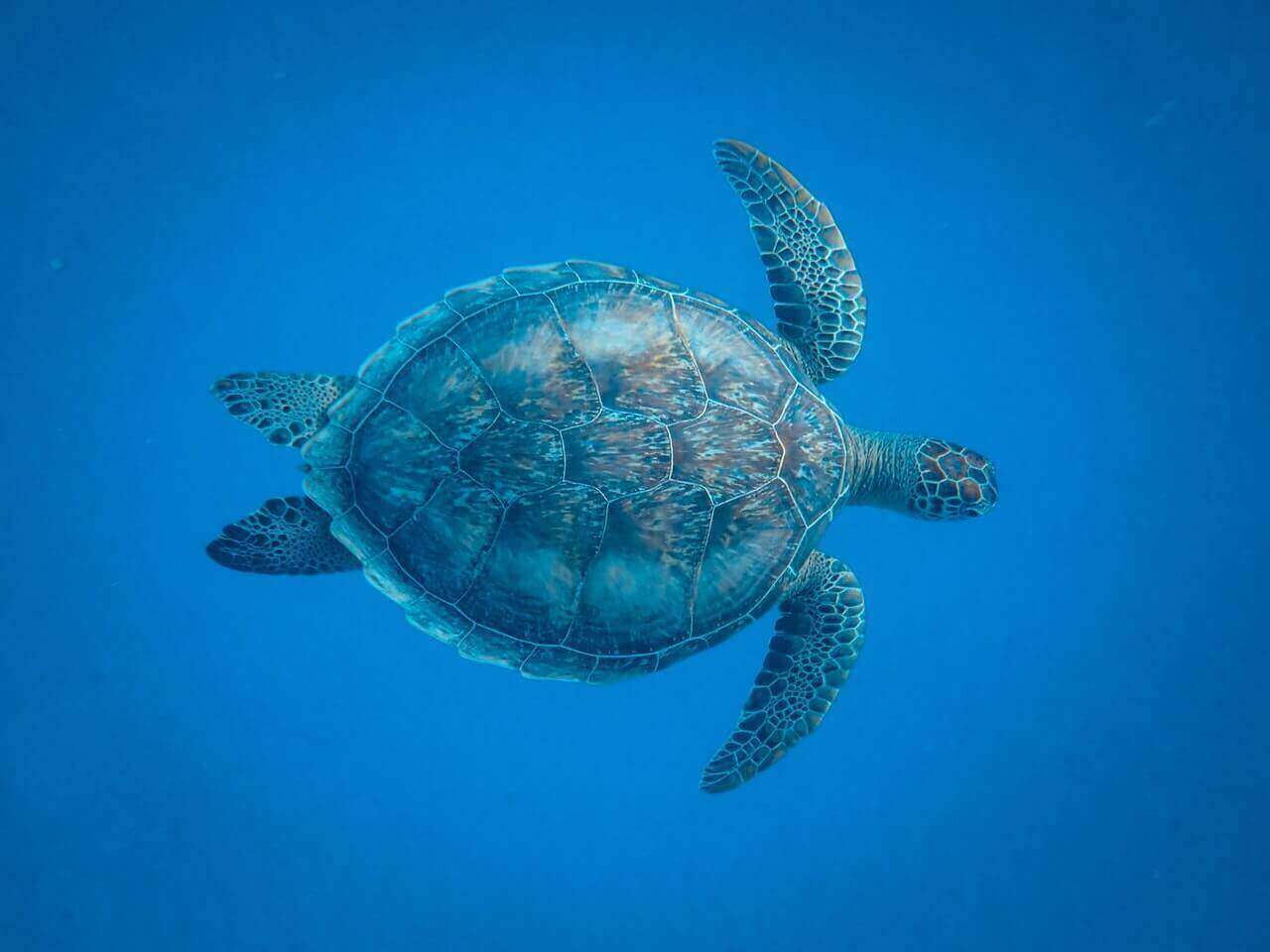One of the most frequently asked questions about turtles is as to whether they sleep. In this article, we answer that question comprehensively: with regard to whether turtles sleep – and if they do, how, when and where they sleep.
Do turtles sleep? Yes, turtles do sleep. They find safe spaces, close their eyes and then go into a deep resting state, which amounts to sleep. Those with shells they can retract into will do so during the sleep hours. Most turtles sleep at night.
During winter months, turtles go into dormancy (hibernation/brumation), where they effectively sleep for several months.
Besides the normal nightly sleep, most turtles will also tend to take naps while basking during the day.

How Do Turtles Sleep?
The sleeping process in turtles can be visualized as having 3 key steps.
In the first step, the turtle finds a safe place to sleep. This has to be a place that is safe from predators. For aquatic turtles, this may be in the mud/sand at the bottom of the water bodies they inhabit.
For sea turtles, this may be in crevices within rocks or coral. And for land turtles, this may be in loose soil, under vegetation, or under piles of rocks.
After finding a safe spot to sleep, the turtle will – as a second step – retract into its shell. It does this in order to be safe from predators.
Once it is safely inside its shell, the turtle will – as the third step – close its eyes and go into a state of deep rest. The turtle will remain in this state for typically between 3 and 7 hours, before waking.
What we have said here also applies to baby turtles sleeping underwater. So if you have been wondering, how do baby turtles sleep underwater, that is how they do it.
One may ask, do turtles sleep during the day or the night? And the answer is that turtles, being diurnal animals, mostly sleep during the night. Then they are active during the day.
Someone may also ask, do turtles sleep during the day while basking? The true position is that turtles do take long naps during the day while basking. But their main sleep is at night.
Another related question: how long do turtles sleep for? The number of hours (for the night sleep) is typically between 3 and 7 hours.
But during winter months, turtles do sleep for virtually entire days and nights – in the state of dormancy known as hibernation/brumation.
Do Turtles Close Their Eyes When They Sleep?
In other words, do turtles sleep with their eyes open? The true position is that turtles typically sleep with their eyes closed.
Turtles that have shells they can retract into first get into those shells. Then they close their eyes, and get into a state of deep rest that we refer to as sleeping.
Therefore if you have been having the do turtles sleep with their eyes closed question, now you have the answer.
Related to this is the do turtles sleep with their head out question. The answer is that turtles with shells they can retract into typically go into those shells, before sleeping. So they don’t sleep with their heads out.
But those that don’t have shells big enough to fully retract into (for instance, sea turtles) typically have to sleep with their heads out.
So that is the answer to the do turtles sleep in their shell question.
However, for the naps that they take during the day while basking, the turtles typically have their heads out.
Still with regard to the mechanics of turtle sleep, one may ask, do turtles sleep on their backs? Or in other words, do turtles sleep upside down?
The answer is that turtles normally don’t sleep on their backs/upside down. But those with respiratory problems (for instance, those that arise from vitamin A insufficiency) may tilt and end up sleeping on their backs.
Therefore if you have been wondering, do turtles sleep upside down in water, now you know the answer.
How Do Box Turtles Sleep?
After answering the how do turtles sleep question at a general level, we can start looking at specific species. We begin with the box turtles.
Now box turtles are in the category of land turtles. As such, they typically sleep on land – normally in loose soil holes/burrows dug under vegetation or under rocks.
The box turtle may identify an ideal spot, and be sleeping there every day.
That, therefore, is the answer to the do turtles sleep on land question. They do: specifically for land turtles, like the box turtle in question here.
One may then want to know: do box turtles sleep at night or during the day? Their main sleep time is at night. But they do take naps while basking during the day.
For the duration of its sleep, the box turtle will retract into its shell, giving it some degree of safety from predators.
If you keep a box turtle as a pet, it may prefer sleeping right on the basking spot in its enclosure. Or it may prefer sleeping within the sand in its enclosure.
How Do Painted Turtles Sleep?
By nature, painted turtles are in the category of pond turtles. When it comes to sleeping, they will typically do it in the mud at the bottom of the ponds they live in.
Therefore if you have been wondering, do painted turtles sleep underwater, now you have the answer. In natural pond settings, these turtles will sleep underwater: that is, in the mud at the bottom of the ponds they live in.
One may then ask, where do painted turtles sleep when kept as pets? Or in other words, where do these pets prefer to sleep while in captivity?
The answer is that, in captivity, they usually prefer to sleep in the water tanks they live in. Or they may at times sleep in the sand within their enclosures. Some may even end up sleeping on their basking spots…
In captivity, the turtles are able to detect that the threat of predators is not really there. So they take more liberty in their choice of sleeping spots.
What we have said with regard to painted turtles also applies for African sideneck turtles.
Suppose, for instance, you wanted to find out, how do African sideneck turtles sleep underwater? What we have said with regard to the painted turtle also mostly applies to it.
In fact, even if you also wanted to find out how do yellow belly turtles sleep underwater, the answer is still along these lines.
After all, these are all turtles that, in nature, live in ponds and other shallow water bodies.
How Do Red Eared Sliders Sleep?
Red eared sliders are in the category of freshwater semi-aquatic turtles. In the wild, they typically sleep underwater – in the mud at the bottom of the calm water bodies they typically live in.
They have also been observed sleeping while floating on the surface of the water bodies they inhabit. They are able to remain afloat thanks to their inflatable throats…
How long do red eared sliders sleep? Or, to put it differently, how many hours do red eared sliders sleep? In one night cycle, a red eared slider will typically sleep for between 3 and 5 hours.
Red eared slider sleeping habits in captivity are, in some ways, similar to those in the wild.
For instance, in captivity, they will still tend to prefer sleeping in the tanks they are kept in. And the duration for which they sleep per night will still tend to be in the 3-5 hour range.
Nonetheless, as with all other turtles, it is worth mentioning that on top of the ‘main’ night sleep, they do still take naps during the day while basking.
That is with the exception of the coldest winter months, when they go into a state of dormancy, which we refer to as hibernation or brumation.
How Do Snapping Turtles Sleep?
Snapping turtles are among the most highly aquatic turtles. When it comes to sleeping, they typically do it in the mud at the bottom of the water bodies they inhibit.
So they go to the bottom of the water bodies they inhabit, close their eyes and go into a state of deep sleep that amounts to sleeping.
Therefore in answering the how do aquatic turtles sleep question, the snapping turtle is a good example. In a nutshell, they sleep underwater.
One may then ask, how do snapping turtles sleep underwater (given that they need oxygen to survive)?
The answer is that they have several adaptations, including the ability to hold breath for long, cloacal respiration (which allows them to draw oxygen from the water they are in) and the ability to lower their metabolisms so that they need very little oxygen.
Some snapping turtles are nocturnal. They are therefore unique in that they do much of their sleeping during the day, and become active at night.
So whereas the answer to the what time do turtles sleep question may be ‘generally at night’, there are also a few exceptions. One of them is the snapping turtle.
Do turtles sleep at night (generally)? The answer is ‘yes’. But there are a few exceptions: like the snapping turtle in question here.
That is similar to what we saw with regard to turtles sleeping in water. Do turtles sleep in water (generally)? The answer is ‘yes’. But there are a few exceptions, like the box turtle we looked at earlier.
How Do Sea Turtles Sleep?
At its core, sleep for sea turtles entails going into a deep resting mode in which they become pretty much immobile.
Before going into this deep resting mode though, the sea turtles will first find a safe spot. In deep seas, this may be on the surface of the sea. But in shallower waters, it typically has to be in rock/coral crevices.
That therefore answers the do sea turtles sleep underwater question? So they do – in near-shore shallower waters. They find rock/coral crevices, underwater, and sleep there.
In the open deep seas though, they tend to sleep on the surface of the water.
That also is the answer to the where do sea turtles sleep question.
How long do sea turtles sleep? The typical duration for which sea turtles sleep is in the 4-7 hour range.
But some – like green sea turtles – have been known to remain in a sleep-like resting mode for up to 11 hours consistently.

How Do Pet Turtles Sleep?
Pet turtles are typically kept in enclosures with tanks. Some types of pet turtles will prefer to sleep in the tanks. Others will prefer to sleep in the enclosures, but outside the tanks.
How do turtles sleep in a tank, yet they need to breathe? The answer is that they have adaptations, which make it possible for them to sleep in the tanks though they need to breathe.
The adaptations include cloacal breathing, the ability to hold their breaths for long (coming up once in a while to draw air) and the ability to slow metabolisms greatly while sleeping.
Besides inside the tanks, the turtles may also sleep in the sand that is often in turtle enclosures. Or they may sleep in the basking spots that are often in the turtle enclosures.
One may then ask, do turtles sleep at night while in captivity? And the answer is that turtles are diurnal animals – both in the wild and in captivity. Therefore they tend to do most of their sleeping at night, rather than during the day.
The do turtles sleep at night or day question is usually from people who observe their turtles also sleeping during the day while basking.
In actual fact, whereas turtles’ main sleeping time is at night, they do also take naps during the day while basking.
One may then wonder, is it bad to wake up your turtle? The true position is if the turtle is sleeping for too long, and you wish to wake it up for, say, feeding purposes, it is not bad.
Also in the course of hibernation, if you notice that the turtle is losing weight too rapidly or has developed infections, it would also be alright to wake it up.
When Do Turtles Sleep?
Turtles typically sleep at night. They are diurnal animals: meaning that they sleep at night, and become active during the day.
Now one of the things that turtles do during the day is basking in the sun. And while basking, they do at times take naps. But their main sleeping time is at night.
Besides the nightly sleep, turtles do have another sort of sleeping, which happens during the winter months. This is hibernation or brumation.
During the winter months, the turtles will go into a months-long state of dormancy, in which they look as if they are sleeping.
In most parts of the US, this sort of sleeping starts in October/November, and ends in March/April.
Where Do Turtles Sleep?
Turtles that inhabit ponds and other shallow water bodies will typically sleep in the mud at the bottom of those water bodies. They can also sleep right on the surface of the water bodies.
Those that live on land will normally sleep in burrows: typically under vegetation or under piles of rocks.
Turtles that live in the sea can either sleep right on the surface of the sea water. This they normally do if they are in deep seas, where they feel safe.
When in swallow, near-shore seas though, they typically go underwater. There, they sleep in the crevices that are on rocks or corals.
One may then ask, where do turtles sleep in the winter? And the answer is that during the winter, some turtles go into the mud at the bottom of the ponds/lakes/seas and other water bodies where they normally live.
That is where they sleep/hibernate for the winter months.
Those that live on land may dig holes, typically in loose soils under vegetation, and sleep there for the entire winter period.
This therefore answers the do turtles sleep underwater question. Yes, they do – for instance, in the mud at the bottom of the ponds, lakes, seas and other water bodies they live in.
One may also ask, how long do turtles sleep underwater? And the answer is that it depends on the type of turtle in question.
There are some turtles that are capable of sleeping underwater for as many as 5-7 hours. Others have to come up on hourly basis, to draw oxygen, before going back in.
During the winter, when their metabolism slows down (meaning that they need much less oxygen), things are different. Then, turtles can sleep under water – in hibernation mode – for several months at a time.
How Long Do Turtles Sleep?
Most turtles sleep for between 5 and 7 hours a night. But there are some that require as few as 3 hours of sleep, and others – like some types of sea turtles – that require as much as 11 hours sleep.
In answering the how much should a turtle sleep question, you need to consider several factors.
You need to consider the type of turtle, its age, its activity levels, the season and the turtle’s personal preferences.
For instance, with regard to age, we see that baby turtles require very much sleep. This therefore answers the do baby turtles sleep a lot question.
But as they grow into juveniles and then into adults, they require less sleep.
Once they are in old age, they start requiring more sleep once again.
With regard to season, we see that all turtles tend to start sleeping more during autumn and winter, and sleeping less during spring and summer.
So there is really no single standard answer for the how long do turtles sleep for question.
Furthermore, in answering the how long do turtles sleep per day question, we have to consider the main sleep session (which they get at night) with the naps they take while basking during the day.
So in answering the how many hours does a turtle sleep question, those are the considerations.
Do Turtles Sleep A Lot?
When you add the hours that turtles sleep at night to the naps they take during the day, it becomes clear that turtles do sleep a lot.
At least in comparison to most other animals, turtles do sleep a lot.
This leads to another question: why do turtles sleep so much? The key reason as to why turtles sleep a lot may be in the fact that they have slow metabolism.
The fact that turtles have slow metabolism makes it possible for them to spend so much of their time sleeping.
Do Turtles Sleep During The Winter?
Turtles do go into a state of dormancy, which some people refer to as hibernation or brumation, during the winter.
During that period of time, they use the energy reserves they had managed to accumulate during the months with friendlier weather.
Some turtles go into this state of dormancy under water: that is, in the mud under the water bodies they inhabit.
Other turtles go into this state of dormancy on land: usually in burrows that they dig in loose soil under vegetation.
What they go into during winter is not real sleep, but rather, a state of dormancy in which they still make little movements.
That is why, strictly speaking, it is referred to as brumation, rather than hibernation.
How Much Should A Turtle Sleep?
The amount of time that a turtle should sleep depends on what type of turtle it is, the turtle’s age, the conditions it is living under, and its personal preferences.
For instance, a green sea turtle may require as much as 11 hours rest, whereas a red eared slider may do well with 3 to 7 hours sleep per night.
A baby turtle may need to spend a great deal of its time sleeping. But a young adult turtle may do well with much less sleep.
In wintry conditions, if temperature and lighting conditions are not controlled, turtles may become lethargic and end up spending most of their time sleeping.
And all factors being constant, some individual turtles just seem to prefer sleeping more than others.
Why Is My Turtle Sleeping So Much?
If you notice your turtle sleeping more than normal, there may be two factors at play.
Firstly, the temperatures under which the turtle is living may have fallen greatly. So you find that the turtle is effectively starting to hibernate.
Secondly, the turtle may be unwell.
If the tendency to sleep too much is accompanied by other symptoms, such as loss of appetite, changes in appearance, buoyancy problems and so on, it may mean that the turtle is unwell.
Final Verdict – Do Turtles Sleep
Turtles do sleep, typically at night, because they are diurnal. For those that live in ponds and lakes, the sleeping place is typically the mud at the bottom of these water bodies.
For those that live in the seas, the sleeping place is either on the surface of the water (if in deep seas) or in crevices under rocks/corals (if in near-shore waters).

Pet turtles may sleep in their tanks. Or they may sleep in the sand that is in their enclosures or even right on their basking spots.
If your pet turtle is sleeping much more than normal, you need to consider the possibility that the temperature conditions it is living under have fallen too much. Or else the pet turtle may be unwell.
As a pet lover, make sure to learn about pet more and give your pet turtle a good and comfortable life!

Welcome to Learn About Pet. My name is Rajkumar Ravichandran and I love all pets, travel, and amazing food. I write about my passion and personal experience caring for multiple pets in this blog! ❤️
Post Disclaimer
DISCLAIMER: THIS BLOG OR WEBSITE, "Learn About Pet", DOES NOT PROVIDE YOU WITH MEDICAL ADVICE AND IS NOT A SUBSTITUTE FOR MEDICAL ADVICE. ALWAYS GET IN TOUCH WITH YOUR PERSONAL VETERINARIAN AND USE INFORMATION HERE AS GENERAL ADVICE.
The information, including but not limited to, text, graphics, images and other material contained on this website are for informational purposes only. No material on this site is intended to be a substitute for professional veterinary advice, food recommendation, diagnosis, or treatment. Always seek the advice of your veterinarian or other qualified health care provider with any questions you may have regarding a medical condition or for pet food related questions.







